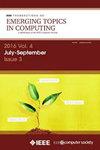单穗 SNN:单梭子相位编码与基数操纵,实现 ANN 到 SNN 转换损失最小化
IF 5.4
2区 计算机科学
Q1 COMPUTER SCIENCE, INFORMATION SYSTEMS
IEEE Transactions on Emerging Topics in Computing
Pub Date : 2024-04-16
DOI:10.1109/TETC.2024.3386893
引用次数: 0
摘要
由于脉冲神经网络(SNNs)是事件驱动的,其能量效率高于传统的人工神经网络(ann)。由于SNN通过离散尖峰传递数据,因此很难使用梯度方法进行训练,从而限制了其准确性。为了保持snn与人工神经网络相似的准确性,将预训练的ANN转换为snn (ANN- To - snn转换)。在转换过程中,将人工神经网络的激活编码为snn中的一组峰值对于最小化转换损失至关重要。在这项工作中,我们提出了一种单尖峰相位编码作为一种编码方案,可以最大限度地减少SNN层之间传输数据的尖峰数量。为了减小相位编码中由于单尖峰近似引起的编码误差,提出了阈值移位和基基处理的方法。在没有对人工神经网络进行任何额外的再训练或架构约束的情况下,本文提出的转换方法在使用CIFAR和ImageNet数据集的三个卷积神经网络(cnn)上验证的推理精度(平均0.58%)没有下降。此外,图卷积网络(GCNs)成功地转换为snn,平均精度损失为0.90%。最重要的是,我们的SNN的能源效率提高了4.6美元!与人工神经网络基线相比,为17.3\倍。本文章由计算机程序翻译,如有差异,请以英文原文为准。
One-Spike SNN: Single-Spike Phase Coding With Base Manipulation for ANN-to-SNN Conversion Loss Minimization
As spiking neural networks (SNNs) are event-driven, energy efficiency is higher than conventional artificial neural networks (ANNs). Since SNN delivers data through discrete spikes, it is difficult to use gradient methods for training, limiting its accuracy. To keep the accuracy of SNNs similar to ANN counterparts, pre-trained ANNs are converted to SNNs (ANN-to-SNN conversion). During the conversion, encoding activations of ANNs to a set of spikes in SNNs is crucial for minimizing the conversion loss. In this work, we propose a single-spike phase coding as an encoding scheme that minimizes the number of spikes to transfer data between SNN layers. To minimize the encoding error due to single-spike approximation in phase coding, threshold shift and base manipulation are proposed. Without any additional retraining or architectural constraints on ANNs, the proposed conversion method does not lose inference accuracy (0.58% on average) verified on three convolutional neural networks (CNNs) with CIFAR and ImageNet datasets. In addition, graph convolutional networks (GCNs) are converted to SNNs successfully with an average accuracy loss of 0.90%. Most importantly, the energy efficiency of our SNN improves by 4.6$\sim\!\! 17.3\times$
求助全文
通过发布文献求助,成功后即可免费获取论文全文。
去求助
来源期刊

IEEE Transactions on Emerging Topics in Computing
Computer Science-Computer Science (miscellaneous)
CiteScore
12.10
自引率
5.10%
发文量
113
期刊介绍:
IEEE Transactions on Emerging Topics in Computing publishes papers on emerging aspects of computer science, computing technology, and computing applications not currently covered by other IEEE Computer Society Transactions. Some examples of emerging topics in computing include: IT for Green, Synthetic and organic computing structures and systems, Advanced analytics, Social/occupational computing, Location-based/client computer systems, Morphic computer design, Electronic game systems, & Health-care IT.
 求助内容:
求助内容: 应助结果提醒方式:
应助结果提醒方式:


